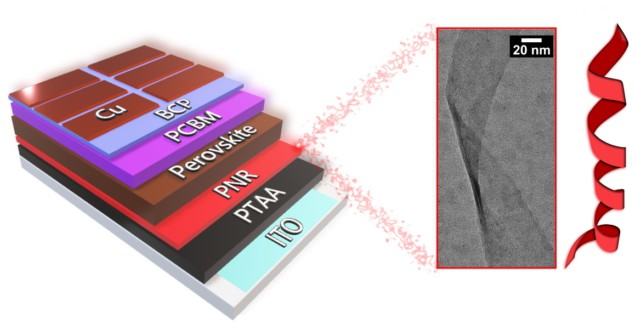
Phosphorene nanoribbons can improve the efficiency of perovskite solar cells, a new study has shown. This is the first time that the benefits of the unique electrical properties of this novel two-dimensional nanomaterial have been experimentally demonstrated. According to the researchers, their results highlight the genuine importance of phosphorene nanoribbons.
Phosphorene consists of a single layer of black phosphorus. Like other two-dimensional materials, such as graphene, it has promising electrical characteristics that make it of interest in various applications. Since phosphorene was first produced in 2014, theoretical studies have suggested that nanoribbons of the material could produce more exciting properties. This is because the edges and confined widths of nanometre-wide strips are expected to exhibit different electrical phenomena to sheets of phosphorene.
“Phosphorene nanoribbons show great promise for optoelectronics given their high exciton binding energies, tunable band gaps, solution processability and ultrahigh hole mobilities,” explains Thomas Macdonald, a chemical engineer at Imperial College London.
Phosphorene nanoribbons were first isolated in 2019. The atomically thin ribbons typically have widths ranging from 4 to 50 nm and lengths of up to 75 μm. But until now, their predicted electronic properties had not been shown in actual devices.

Now, Macdonald and his colleagues have experimentally demonstrated the potential of phosphorene nanoribbons, by incorporating them into perovskite solar cells. The nanoribbons improved the efficiency of the solar cells by enhancing electrical transport between the light-absorbing perovskite layer and a semiconducting polymer. They report their results in the Journal of the American Chemical Society.
Perovskite solar cells are made from a class of materials that have a similar crystal structure to the mineral perovskite, rather than the more usual crystalline silicon. They can be created using a solution method, which makes them cheaper to produce than their silicon cousins. These newer solar cells are also thinner, making them lighter and more flexible.
“The valence band of phosphorene nanoribbons is ideally suited to promote hole-transfer between a perovskite absorber and its corresponding hole transport material in perovskite solar cells,” Macdonald says. “Since hole transport materials represent one of the major bottlenecks to further enhancing perovskite solar cell performance, phosphorene nanoribbons were incorporated as solution-processable nanomaterials.”
The team inserted the nanoribbons into a few different types of perovskite solar cells, between the perovskite layer and a polymer layer, which acted as the hole, or electron, transport layer. This layer is used in such solar cells to enhance carrier transport between the perovskite and the electrodes. They then compared the new devices with control perovskite solar cells that lacked the phosphorene nanoribbons. The nanoribbons increased the power conversion efficiencies of the solar cells from around 18% to above 21% – on a par with traditional silicon solar cells.
To examine the mechanisms behind the enhanced efficiencies, the researchers turned to photoluminescence and transient absorption spectroscopy. They showed that the nanoribbons enhance various parameters linked to electron transport, increasing the speed of electrical transport between the layers.
Macdonald tells Physics World that the team demonstrated that phosphorene nanoribbons are extremely effective as a charge-selective interlayer by enhancing hole extraction from the perovskite to the polymer semiconductor. “The functional electronic properties of the phosphorene nanoribbons improve the functionality of perovskite solar cells via more effective carrier extraction,” he adds. “In other words, the property we exploited here is that charge carriers can move fast in phosphorene nanoribbons.”

Ionic scissors cut out phosphorene nanoribbons
Aditya Mohite, a chemical engineer at Rice University in the US, who was not involved in the research, tells Physics World that the phosphorene ribbons seem to improve the charge collection as observed in the fill factor (a measure of solar cell efficiency). “It emphasizes the importance of using interface layers in perovskite photovoltaic devices to improve performance,” he adds. He cautions, however, that phosphorene nanoribbons could impact durability as they are moisture sensitive.
The unique properties of phosphorene nanoribbons could also benefit other devices, such as photodetectors, light-emitting diodes and hydrogen fuel cells, according to Macdonald. He notes that they could be particularly beneficial in batteries for electrical vehicles by dramatically speeding up the movement of charged ions, leading to significant increases in storage capacity and decreases in charging times.



